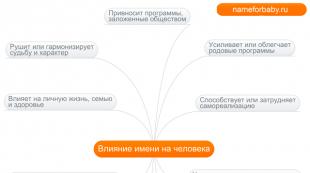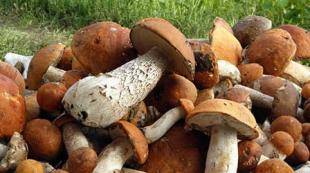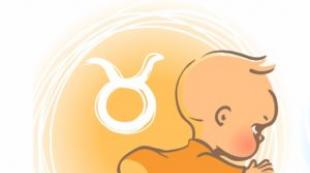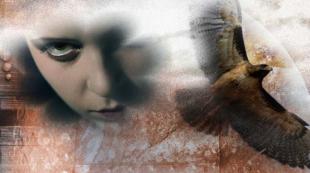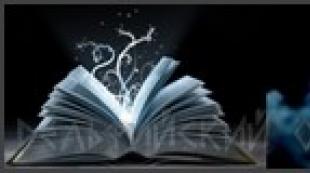Interest in reading in younger students. How to develop it
Send your good work in the knowledge base is simple. Use the form below
Students, graduate students, young scientists who use the knowledge base in their studies and work will be very grateful to you.
Similar Documents
Analysis of the specifics of the formation of students' cognitive interest in reading lessons. Peculiarities of children's reading activity. Methodological development for the development of interest in reading among younger students. A selection of books for children to read on their own.
thesis, added 11/13/2015
The value of design for the comprehensive development of preschoolers, the content of the work of the educator in the development of building games for children. The use of modern designers in the process of games. Acquaintance with the basics of architecture for preschool children.
term paper, added 05/26/2012
Acquaintance with the age and individual characteristics of a group of preschool children. Observation and analysis of the leadership of didactic and creative games, the labor process of preschoolers. Organization of interaction between the teacher and parents.
practice report, added 02/06/2011
The problem of forming interest in the book and the sequence of developing in children a craving for reading fiction. The role of methods of pedagogical influence on this process. Diagnosis of the level of formation of reading skills in young children.
thesis, added 01.10.2013
The development of speech of a preschooler in ontogenesis. The development of the phonetic-phonemic aspect of speech. Psychological and pedagogical prerequisites for acquiring literacy. Problems of teaching reading to children with speech disorders. Formation of skills in the analysis of linguistic facts in speech.
term paper, added 05/03/2012
The problem of the formation of reader's interest in domestic psychological and pedagogical research. Peculiarities of children's perception of literary works. The content and methodology of work on the formation of reader interest in older preschoolers.
thesis, added 12/24/2017
The study of the features of cognitive interest and activity of preschool children. Stages of development and conditions for the formation of this selective orientation of the personality. Ways of developing interest in teaching older preschoolers by means of didactic games.
term paper, added 12/09/2014
Psychological and pedagogical foundations for the formation of interest in ethnoculture among preschool children. Familiarization of preschoolers with the arts and crafts of the Armenian people. Diagnosis of the level of formation of interest in Armenian culture.
thesis, added 12/24/2017
Reading is a difficult and sometimes painful process that takes a lot of time and effort from children. And until the child learns to read quickly and meaningfully, to think and empathize while reading, this process will not give him joy and pleasure. But, as a rule, the development of certain skills is facilitated by the implementation of multiple training exercises, which rarely attract anyone with their monotony and monotony. The task of the teacher is to find an attractive moment in them, to present them to children in such a way that they are performed with interest and desire. How can I do that?
The methodology knows many methods for developing reading techniques, i.e. the correct way of reading, correctness, tempo and partly expressiveness.
The main one is multi-reading, a technique in which the student, answering a particular question, expressing his point of view, seeks reinforcement for his thoughts, judgments, feelings in the text, referring to it again and again. This repeated appeal to the text each time will reveal to the student in the already familiar text something new, unexpected, surprising him and at the same time interesting. At the same time, the depth of immersion in a literary text increases, and interest in reading increases.
Types of work in reading lessons:
1. Reading the entire text
2. Reading the text, with the aim of dividing into parts and drawing up a plan
3. Reading according to the finished plan
4. Reading with text reduction (children do not read sentences or words that can be omitted). Preparing for a Condensed Retelling
5. Reading in a chain by sentence
6. Reading in a paragraph by chain
7. Reading in order to find a suitable passage for the drawing
8. Reading to find a passage that will help answer the question
9. Reading the most beautiful place in the text
10. Finding the whole sentence at the given beginning or end of the sentence. (Later the sentence can be replaced by a logically complete passage)
11. Finding a sentence or passage that reflects the main idea of the text
12. Reading in order to find 3 (4.5...) conclusions in the text
13. Establishing Cause-and-Effect Relationships by Reading
14. Reading by roles in order to most accurately and fully convey the characters of the characters
15. Reading by dialogue roles, excluding the words of the author
16. Finding and reading figurative words and descriptions
17. Finding and reading words with logical stress
18. Isolation of a word from the text to the proposed scheme, for example: ch, lei
19. Who will quickly find a word for a certain rule in the text
20. Finding the longest word in the text
21. Finding two-, three-, four-syllable words
22. Finding in the text and reading combinations: pronoun + verb, etc.
23. Reading with marks of obscure words
24. Finding and reading in the text words that are close in meaning to the given words are written on the board)
Probably everyone will agree that any action that is dictated from above, and in which a person has no personal interest, is performed reluctantly and, as a rule, gives little benefit. Therefore, it is very important for the teacher to provide the student with the right of free choice. It is readily read, actively perceived and gives the impression of what is relevant to the reader, which makes him act on his own initiative, independently.
Below we will consider the main types of reading.
Returning reading is a rereading of works already familiar to children after a while. Such reading contributes to the development in children of a positive attitude towards communication with the book by satisfying their need to re-experience the plots and images that captured their imagination. At the same time, there is a deepening and reassessment of the impressions received earlier, when the perceived images emerge in memory and are highlighted in a new way, bringing the child closer to understanding the ideological and artistic meaning of the work.
The main point of the “returning” reading lesson is to make suggestions in the class about “why Sasha or Natasha wanted to reread this work.” It is also necessary not only to reveal to children the importance of revisiting a work as an opportunity for an additional meeting with their favorite characters and their authors, but also to help students identify new meanings of the work, leading children to realize their renewed perception of what they read.
Free reading is the student's turning to reading at his own request and with the right to decide for himself: why should he read, what exactly to read, how to read and when to read. The meaning of this reading is as follows:
Love for reading cannot arise without the child having the opportunity to freely determine his attitude towards him, including interest in the content of reading, the personality of the author or in the pursuit of spiritual growth, the desire to keep up with others in reading skills, etc.
Free reading as reading without limits constraining the child allows him to read to the best of his ability and in optimal conditions for himself to conduct a dialogue with the author of the work, which in itself stimulates the desire to conduct this dialogue. Free reading provides the child with the opportunity to express their reading interests.
Psychologists have established that at each age stage of human development, a leading type of activity is formed that contributes to the development of personality. For younger students, this is an educational activity, during which the student masters theoretical knowledge and at the same time develops arbitrariness of behavior, abstract thinking, and thinking memory. The student from the object of learning becomes the subject of learning. Knowledge is acquired by him not in general, but in the form of educational activity.
General structural elements of educational activity: educational task, goal and motive, indicative and performing actions, self-control and self-assessment of the product of activity - should always be present in training. This means that the content of training should be not only subject knowledge, skills and abilities, but also activities for their assimilation. Reliance on the motivation of learning, knowledge of the methods of action for solving a problem, operations for the assimilation of knowledge - this is something new that is gradually being introduced into the practice of elementary school.
Thus, the activity of the child is directed to the formation of general mental actions - the ability to learn and special objective actions in the system of any educational course.
Teaching reading should also be included in the system of formation of educational activity. The peculiarity of reading lies in the fact that it is not only a subject (special), but also a general educational skill, on which the success of teaching a child in other subjects depends. Reading as one of the types of speech activity correlates with the general structure of activity, including educational, therefore, the reading skill cannot be fully formed without the motivation of learning, without the presence of indicative and performing actions in the process of mastering it, and also without educating students' feelings. self-control and self-esteem.
Reading is carried out with the help of literature, but the main problem is the formation of the reader at the initial stage of his development, namely: mastering strong reading skills and ways of working with fiction and popular science text.
Despite the fact that elementary school is called a school of skill, which underestimates the general or mental development of the child, it can be argued that the reading skill is formed at the level of the primer. Further, the reading skill develops spontaneously and its formation is not controlled. That is why some students do not understand the meaning of the text, especially in the process of reading it silently, they read slowly, with the presence of residual external speech movements, and their reading aloud is technically imperfect, inexpressive. They hardly understand and remember the condition of an arithmetic problem, find it difficult to isolate the main thing in a scientific and educational article, educational text.
As the famous critic and philosopher I.F. Karjakin: "As long as the student treats literature only as evidence of what happens to others, and not to himself, until he recognizes his own in someone else ... until he is burned by this discovery - until then there is no interest in reading, no and needs for it.
A positive attitude towards reading, in his opinion, begins from the moment when:
The child will feel like a participant in the events that are depicted by the writer,
When he discovers personal meaning in what he reads, when the book appears before him as a space for the realization of his own creative potential.
The work of a teacher in analyzing a work of art will be effective only when the child is interested in reading, in literature in general. Only then will the lesson not just talk about some work, but there will be a confidential conversation that will deeply affect the child, make you think about something and acquire something important for yourself. Only then will each new work be for the child as a discovery of something new for him personally.
Sukhomlinsky writes: “What a child needs to remember and learn, first of all, should be interesting for him.”
Therefore, the problem of awakening and developing interest in reading as a unique activity and cultural phenomenon is of particular importance.
There is an opinion that the sooner you start accustoming a child to a particular type of activity, the better the result will be. To get results, you need a system.
The beginning of this system is in the family. First of all, the child adopts the attitude towards reading and the book that exists in his parents. Not without reason, back in the 16th century, the lines were written: A child learns what he sees in his home - parents are an example to him.
And if the parents are literate and thinking people, then they will be the first to start working on shaping the child's interest in the book. How can they do it?
But the leading role in solving this problem belongs to reading lessons.
An analysis of existing programs for literary reading of primary school students shows that, despite the positive changes in the system of work on literary education of primary school students, the programs are still imperfect.
So, for example, the main attention is paid to the development of the technical side of reading (reading technique) and the semantic side (teaching the analysis of a work of art). The requirements for a child at the initial stage of literary education are mainly aimed at the knowledge, skills and abilities of the child, and not at his individual development.
How should a teacher act? Of course, you need to start by taking into account the age characteristics of younger students.
At the age of 7-9 years, there is an extremely rapid development of the emotional sphere, the so-called sensory intelligence.
Paying great attention to this feature of primary school age, the teacher can achieve high efficiency in his work on literary reading.
It is at the primary school age that the accumulation of feelings and experiences takes place by leaps and bounds. Therefore, younger students are looking for entertainment, strong emotional experiences in reading. Their imagination is captured by action-packed works, heroic deeds seem to be the norm of life, and their favorite heroes are, first of all, heroes of action.
Children of primary school age need works that teach them to be surprised. The ability to be surprised by an event, a phenomenon, a person is very necessary for a child: interest in life, a thirst for knowledge, the ability to see beauty and cherish it are born from surprise.
By ignoring the literary predilections of students of this age, it is possible for many years to "kill" their interest not only in literature as an academic subject, but in reading in general.
What features of readers of primary school age should the teacher take into account when preparing for the lesson?
The little reader reacts to the text primarily emotionally. Children's experiences associated with the text are of great value for elementary school. The importance for the child of the ability to feel, to experience has been written more than once. Let us recall the famous words of V.G. Belinsky, who believed that the main thing in the process of reading is for children to "feel" as much as possible:
"Let the poetry of the word act on them, like music, right through the heart, past the head, for which its time will come" V.G. Belinsky.
Another feature of readers of primary school age is the identification of the artistic world and the real world. It is no coincidence that this period in the development of the reader is called the age of "naive realism." This is expressed in relation to the character as to a living, real; in showing confidence in his portrayal. Thinking concretely, children constantly ask: "Did it really happen?"
It should be noted that younger students have sensitivity to the word and to the artistic detail. The child sometimes reacts to such psychological subtleties that adults sometimes do not notice.
Inherent in younger students is the so-called presence effect, which means the child's ability to live in the image.
The final feature of the younger reader is the lack of response to the art form.
These qualities of perception of younger students are a support for the teacher in the process of developing their interest in a literary work, and therefore in a reading lesson.
At the lesson, the teacher needs to show the children that reading is communication, a dialogue between the reader and the author. But this communication is not direct, but communication through a text created by the author.
If the teacher adheres to the premise that in a work of art it is important not only what is written, but also how it is written, by what means, then the children will definitely pay attention to the artistic form of the work, which is more important in artistic speech than in ordinary speech. communication.
The main educational result of reading lessons in elementary school should be that they arouse in children an interest in subsequent literary education, arouse a thirst for literary knowledge proper in order to answer more and more new questions: not only about what and how the book told them and who was their interlocutor, but also why the author speaks about it, why he speaks, why he speaks this way and not otherwise, and why the author manages to evoke such thoughts and feelings in readers.
Kolpakova Natalia
Formation of interest in reading fiction in preschool children.
Kolpakova N. B. educator MBDOU DS No. 390, Chelyabinsk
People stop thinking
Danny Diderot
Instill in your child a taste for reading -
the best gift we can give him.
When I was 6 years old, I really wanted to quickly learn to read. My parents always read to my sister and me. Not a day went by without reading. But I still missed him. I dreamed about how I myself will plunge into the magical world literature, I will be next to the heroes of fairy tales and stories and no one say: "Enough for today".
Unfortunately, at the present time you will not often meet families in which parents instill in their children a love of the book. There are fewer people who read. In the best case, the mother reads to the baby for a few minutes before going to bed. Adults are always busy or tired. Parental attention to children is replaced by a TV and a computer. It is unfortunate that the meaning of the book, fiction is underestimated today.
« Reading is the best teaching. To follow the thought of a great man is the most entertaining science ”- maybe someone will remember at least the first part of this statement by A. S. Pushkin. and here's another one: It is no exaggeration to say that reading in the years of childhood it is, first of all, the education of the heart, the touch of human nobility to the innermost corners of the child's soul. A word that reveals noble ideas forever deposits in a child's heart grains of humanity that make up conscience. These are the words of V. A. Sukhomlinsky. Maybe because modern children do not feel the need for reading, because "grains of humanity" less and less in our lives.
Benefits cannot be underestimated reading. Primarily, reading develops speech and affects the quality and quantity of the child's vocabulary. A person who reads has a better memory and concentration. Reading helps in the development of figurative thinking and in teaching literacy, makes it possible to learn to analyze, capture the meaning, develops oratory skills. If parents regularly read to their child art books, then the baby expands his horizons, increases intelligence, formed cognitive activity and positive moral qualities. For example literary characters, the child learns to respect the world around him, learns the intricacies of human relationships.
The child's love for books, planted in childhood, will help form perseverance and help in learning (development of strong-willed effort when performing tasks of varying complexity).
The question arises when to start instilling love for the book, develop interest in reading fiction?
From the earliest age you can read aloud to your child. A few minutes a day. Let it be fun and jokes. Such reading contributes to the emotional development of the baby, his rapprochement with the mother. Based on my own experience, I can say that in a few days the child will begin to pay attention to the book in the hands of the mother and smile. I started reading to my son, and it’s not easy to tell fairy tales and nursery rhymes aloud when he was 5-6 months old.
But the most optimal for adaptation to Reading psychologists consider the age of three to seven years. The best time for reading considered time before bedtime. This can become a good ritual that helps the child relieve the tension that has accumulated during the day, push all problems into the background, and relax. However, it is worth reading during the day. With age children need more and more information, the need for positive emotions is growing. Therefore, it is worth gradually increasing the time reading and increase the level of complexity of the books. Children listen with pleasure, and more than once, to fairy tales based on which cartoons: "The Adventures of Leopold the Cat", "Three from Prostokvashino", "Winnie the Pooh", Carlson, "The Adventures of Pinocchio", "Dr. Aibolit" etc. Even if the child has already seen the cartoon, read the story. Unlike animation, which is perceived as a set of individual frames and the child does not catch the meaning, books make you think and experience.
In recent years, as an educator, I have noticed that the number of children with speech problems. And sometimes, even at 3-4 years old, the child does not have the vocabulary recommended by the kindergarten program and cannot express what he wants. Therefore, parents should be encouraged to read to their children as much as possible. Reading will increase the child's vocabulary, help develop phonemic hearing and the ability to pronounce sounds correctly, learn to understand different intonations.
I often talk with the parents of my pupils about the benefits reading. I recommend which books and when to read. I try to find out what my child likes to do in his free time at home. Many parents listen to advice. Today, thanks to the joint efforts of teachers and parents, in our group of 24 pupils, only five, unfortunately, do not show interest in reading.
Here are some tips for parents on how to teach preschooler to read:
1. Let the child understand that reading It's a great pleasure, incomparable with anything. In this case, your personal example will be the most effective. Read for yourself. Tell your child what the book is about. Children love to imitate adults.
3. Even when the child learns to read, do not stop reading aloud to him for as long as possible. Expressive reading adults will help to connect the words with the images that arise in his imagination. An adult will help to understand the text by explaining the meaning of unfamiliar words and expressions and answering questions. At 7-9 years old, it is difficult for a child to focus on one thing for a long time, his eyes get tired quickly, some phrases and words may be incomprehensible. So reading becomes an unpleasant occupation and this hostility can be fixed for life.
5. At 5-7 years old, read "with continuation", interrupting reading in an interesting place. This will intrigue the child, make him want to know what will happen next.
6. After reading a book, don't "forget" about her. Let it become the subject of discussion, dispute, exchange of impressions. Invite the child to compose a story, imagine himself in the place of the heroes, find his own solution to the situation.
7. Read books with good illustrations. Try to remember the last name with your child graphic designer. Offer to come up with and draw your own pictures for the work, a portrait of the hero.
8. Take your child to the library. Consider different publications: art books, reference books, albums.
9. Buy educational books and children's encyclopedias with the most interesting information for the child, deluxe editions with beautiful photographs: space, cats, dinosaurs, countries, dolls, etc.
10. Cultivate a respect for the book. Tell your child about handling book: you can not draw on the pages, bend the book, cut out pictures, use books instead of cubes, etc.
11. Can "revive" characters of fairy tales and stories, molding them from plasticine or gluing them from paper and arranging a home theater.
12. Designate a special place in the room where the child's books will be, so that he himself can take them when he wants.
13. Do not try to replace the TV or computer with a book. Just clearly regulate the time of watching TV shows and computer games.
14. You can start a family tradition reading - 2-3 times a week, in the evenings, arrange an hour reading. At the same time, the TV and computer are turned off and all family members, without exception, take part in the event.
Years of experience with preschoolers proves that work on It is very important to develop children's interest in reading. Improving the skills of speech culture is a necessary component of education, human intelligence. The speech of any person, enriched with well-aimed sayings, figurative expressions, phraseological units, proverbs and sayings, becomes bright, lively, expressive. Therefore, I would like to give some recommendations to young teachers.
1. In kindergarten, it is advisable to start reading to children from an early age. age, gradually complicating the subject. Products are best selected according to the season. For example, in winter it is advisable to read fairy tales to children "The Snow Queen", "12 months", fairy tale "Adventures in Dedmorozovka", "Winter in Prostokvashino", poems about the New Year's holiday and about winter, riddles about the weather and natural phenomena. Then the heroes of the works can become characters in children's drawings, applications, collective children's works. In the scenarios of New Year's morning performances, there are also heroes of winter fairy tales performed by children and adults.
2. During reading be sure to consider and compare illustrations of different artists to one work. After reading In books, I often suggest that children draw their favorite characters, make illustrations. The children are happy to take on the role. graphic designer, invent landscapes and portraits.
3. In addition, be sure to conduct a discussion of the reading, during which you learn children analyze different situations and actions of the heroes of the work. Give children the opportunity to express their attitude to what they heard and come up with their own ways of solving and acting in problem situations. situations:
How could you answer?
Why shouldn't it have been done that way?
What can be done to correct the error;
How to make peace, etc.
As a result, children transfer the positive experience of the relationship of heroes into their lives. The names of some characters become common nouns.
4. When reading literary works pay attention children not only on the content, but also on their art form. Through this you will learn children to distinguish between literary genres(fairy tale, story, poem, nursery rhyme, proverb, saying, riddle, understand the meaning of figurative expressions and phraseological units, develop a poetic ear.
5. While reading, focus on the characteristics and mood of the characters, their dialogues and relationships, description of facial expressions and gestures. You can invite children to portray the character they like, compare it with other characters.
6. Use artistic works not only in the classroom. Read to children at any convenient time time: in the morning and evening, when the weather is bad, before going to bed.
7. Talk to children about the books their parents read to them.
8. Start a tradition in your group to celebrate a book holiday. for example:
Having taught children love books, you will teach them to love and understand their native language, to express their thoughts grammatically correctly, logically, expressively, accurately. After all, according to how a person builds his statement, how much interesting he knows how to tell, one can judge his mental, emotional and aesthetic development.
AT At present, the problem of developing schoolchildren's interest in reading is becoming a generational problem: the book in any of its forms is moving away faster and faster, interest in reading is declining. Television, the Internet are gradually replacing the book from the pedestal that it occupied until recently. Now, in order to know and keep abreast of the latest achievements of scientific thought, it is not at all necessary to read. It is enough to draw information from the TV screen or display. Children master the computer before they learn to read, navigate the keyboard better than the table of contents of the book. Their literary experience is limited to attempts to master the works of the school curriculum in an abridged version. It is bitter, painful, insulting, because once we were the most reading country in the world. The teacher of literature, in my opinion, faces one of the most important tasks of our time - to revive the student's interest in reading, which has been relegated to the background.
It is impossible to educate a creative person without a book: reading develops cognitive processes, personal culture, and forms receptivity. The process of learning to read should be continuous from elementary school onward and should ideally teach the child to see the book as a work of art. Traditionally, acquaintance with literature at the middle level begins with the study of folklore. A characteristic feature of this course is the first acquaintance of the student with the concept of expressive means of the literary language. In this regard, folklore is the richest material for such literary devices as allegory, simile, metaphor, epithets, personification, and others. From the point of view of the development of "ability to read" for me, as a teacher of literature, the following types of tasks are interesting:
1) consider typical fairy-tale animals and determine what features of the human character they identify;
2) trace which folk human names are traditional for animals and people in Russian fairy tales, and which in foreign ones, and how this is connected with the character of the hero;
3) draw the student's attention to the similarity of many folk tales;
4) analyze the epithets used to describe negative and positive characters (for example, 2-3 fairy tales), what comparisons are used in this case;
5) invite students to determine the character and appearance of the hero using the epithets written out;
6) characterize the hero from the illustrations to the fairy tale, using the appropriate literary techniques (for this task, the use of reproductions of popular print and Palekh painting in the lesson is especially effective), students of grade 5 can be invited to draw an illustration for the work themselves;
7) create a presentation of your favorite fairy tale or favorite character.
According to my observations, such tasks awaken students' interest in the text as an object of study. And the elements of the game and competition make it easier for students to get acquainted with the basics of literary criticism and develop the skills of analyzing literary works.
In order to increase reader interest and general aesthetic development, it is advisable to use interdisciplinary connections more widely, primarily between fine arts and music. As a result, I am doing the following:
I suggest that the children make verbal portraits of the characters by listening to musical passages;
I propose to compare episodes from musical and literary works and analyze expressive means;
I organize a quiz "Guess who's coming?" (by a musical fragment, determine the hero, find a match in the text of the work);
I propose to prepare illustrations of the most memorable moments of the work.
In the process of studying poetic works, it is necessary to achieve students' understanding that a poem is a poetic image, and not just rhyme and rhythm. The most effective way to develop reading skills is the widespread use of expressive reading in the classroom. From the point of view of V.I. Chernyshev, “reading is clear, distinct, although not loud” is easy to listen to and understand, the main thing when reading is “to express the feeling of what is being read, and not one’s own”, which is possible only if one deeply penetrates into the content of the text. The ability to think about what is read and convey what is understood by the movement of the voice, intonation, has a beneficial effect on the formation of communication skills.
Forming the skills of mature reading in students, I, as a teacher, prepare them to perform various types of reproduction of what they have read, primarily to retell - short and detailed. On the basis of reading and analyzing texts, students master the skills of presenting their own thoughts: they follow the path from observing thoughts to independently reproducing thoughts.
Due to the large volume of the text of a literary work studied in high school, there is a problem of lack of study time for a more detailed consideration of all the points of interest of the work, therefore, extracurricular thematic events are of great help in increasing the interest of schoolchildren in the work. In my opinion, the following activities have the greatest interest and practical effect:
1) literary evenings, where students are invited to stage an episode of various literary works (moreover, both works and episodes can be chosen independently by schoolchildren within the framework of the theme of the literary evening);
2) literary "Brain Ring", "What? Where? When?”, “Happy chance”, “The smartest”, “Clever and clever”, where the participating teams are offered excerpts from the work in order to determine the author and title; you can prepare questions on the work or creativity of any writer, determined by the theme of the game (in this case, the questions can be prepared by the students themselves).
These activities make it possible to assess the horizons, areas of interest, the degree of susceptibility of a literary text by students, as well as to trace the dynamics of the child's intellectual development.
I strongly recommend that high school students keep a reading diary, the purpose of which is to help prepare for the lesson and, most importantly, help prepare for the exam. In the reader's diary, I highlight the following sections:
2. Title of the work
3. Main characters (their characteristics)
5.Problems
6. Commentary on the problems (short)
7. Note (what the work teaches, what you liked, the general impression, maybe some aphorisms, etc.)
The reader's diary is one of the ways to support reading in schools, to instill a culture of reading, to control the student's activity as a reader.
One of the effective ways to increase the reading interest of high school students, I think, is to conduct extracurricular reading lessons. These are not standard classes, but lessons based on the material of modern youth literature, which are held in conjunction with the children's library No. 8.
Modern literature is of particular interest to teenagers. How to make extracurricular reading lessons on this topic interesting and necessary for modern boys and girls? Together with the children's library, we conduct extracurricular reading lessons based on works of modern literature. The guys offer a work of modern literature, with which we go to the library for discussion. The responsible group prepares an abstract, additional questions and video material. The teacher and the librarian think over the form of the lesson, develop questions for the debate.
Collaboration with the children's library creates conditions for conducting interesting lessons on modern literature, which arouses a keen interest in adolescents, a desire to read works of Russian literature.
Without a personal example of a teacher, I think it is impossible to arouse interest in reading, so I go to the library with children with pleasure, observe the manifestation of their reading interest, choose books together, try to find answers to our questions. To teach a child to think, to reason, to awaken in him feelings and a desire to create - this, in my opinion, is the most cherished desire of any teacher.
We live in difficult times and only the ability to dialogue will allow us all to preserve human dignity and always remember “how our word will respond” in the hearts and minds of our students...
G. N. KOZLOVA
FORMATION OF INTEREST IN READING THROUGH LITERARY GAME AND CREATIVITY
In the famous book by V.A. Sukhomlinsky: “I give my heart to children”, there is a chapter in which the great teacher writes: “Teaching should not be reduced to the continuous accumulation of knowledge, to memory training ... I want children to be travelers, discoverers and creators in this world ".
To instill in a child an interest, love and taste for reading is the best gift we can give him. But how can this be achieved? Everyone who works with younger students knows how difficult it is to teach a child the technique of reading, but it is even more difficult to raise an enthusiastic reader who lives in the 21st century, the century of technology and computerization.
Therefore, it is so important that the love for a high-quality book, whose artistic level has been tested for centuries, remains in the soul of every growing person forever. It is the age of the junior schoolchild that scientists call especially sensitive to the perception of beauty, goodness and justice, because in these years the moral basis of a person is laid. When getting acquainted with fascinating and instructive books, the guys will recognize the heroes, one of which they want to imitate, and others - to protect.
In recent years, literary education has become more and more confident in the process of teaching younger students. The most important skills that a child acquires, plunging into an interesting literary world for him, are, first of all, cognitive processes, as a result of which the child realizes the meaning and idea of the work; further - the connection of children's fantasy and imagination, allowing the child to vividly imagine the course of the events described, and emotionally - personal assessment of the content. The approach to literature in the primary grades as an art form provides ample opportunities for the development of versatile creativity, both for the teacher and the student himself. A creatively liberated, emotionally attuned child feels and understands what he read more deeply.
In my work with children, I try to implement the basic principles of pedagogy of co-creation. The pedagogical formula of Korney Ivanovich Chukovsky helps me to solve this problem in practice: "Game - creativity - development."
I will not open "America" if I say that there are no children who are not capable of anything. Every child is talented in their own way. My task as a teacher is to create conditions for the awakening and development of the child's own creative abilities. In order to give every child the opportunity to express himself in the lessons of literary reading, I try to use various methods and forms of work, combine various activities aimed at the comprehensive development of the personality of the little reader, at the development of his own creative abilities. In my lessons, reading literary works is organically intertwined with drawing, writing, and playing. Tasks put children in an active position, arouse interest, develop imagination and fantasy, and contribute to emotional responsiveness. All tasks are aimed at awakening creative activity and allow you to learn a lot in a playful, entertaining way.
In my lessons, I often use literary games. They are interesting and useful for children of all classes. I use the game at the end of the lesson, in order for children to better remember literary heroes, I give children the necessary relaxation after hard work, in general lessons, in extracurricular reading lessons.
In my work I use games: “Literary Lotto”, “Magic Basket”, “Guess the Fairy Tale”, “Who is Faster”, “Flower - Seven-Color”, “Where the Hero Lives” and many others.
For example, "Country Poetry". The purpose of this game is to recall excerpts from literary works well known to children in a game competitive form. So that listening to poetic lines does not become passive, I suggest that each of the children try to remember which book this or that passage is from, name the title of the book and its author, or I suggest preparing a task for the guys themselves in advance. And if the memory is good, then continue reading the whole work.
"Literary Lotto" is one of the simplest games that allow children to realize book knowledge. In this game, the host calls the name of the character, and the second player - his characteristics.
Another literary game that my children really like is "From a riddle to a fairy tale." To conduct such a game, you will need to “link” the riddles you have about familiar objects with the plots of famous fairy tales. For example: let's play with the word "apple" - many fairy tales and riddles are associated with this subject. To begin with - who will guess more riddles about apples. Then we recall fairy tales, where apples were a characteristic magical attribute, or we conduct a quiz about folk tales. For example, have the children think and answer the following questions:
What magical object replaced the TV in fairy tales? (a pouring apple and a golden saucer).
What did the evil stepmother give to her stepdaughter, the princess? (poisoned apple).
What magical fruits in fairy tales could turn old people into young people? (rejuvenating apples).
You can beat the phenomena of nature, animals, various household items found in fairy tales.
Traditional games are also known, which are based on recognizing works of art from individual drawings or passages, recreating lines and stanzas from given words or illustrations, posing and solving “tricky” questions about books read (quizzes and crossword puzzles), guessing the names of literary heroes, surnames writers, the title of books and works on a series of questions (charades, literary opinions), the reproduction of heroes and books according to the description, the compilation of literary games on the principle of “what is missing” (writer - work; hero - book - writer).
I use literary charades. A charade is a game - a riddle. In the hidden word, the name of a literary hero, the title of a book or work, the surname of the writer can be hidden. For example: there are two parts in a word. The first part is a vowel that begins the Russian alphabet. Part two - the name of a predatory cunning beast that lives in our forests. The whole is the name of the heroine of a wonderful fairy tale written by an English professor of mathematics and published in our country in the translation of Boris Zakhoder.
At first, children are only interested in the form of the game itself, but then the material, without which it is impossible to participate in it. In addition, the game stimulates interest in winning. Therefore, children try to clearly perform tasks, observing the rules of the game. They learn to work together, learn to be attentive, and then they themselves show interest in inventing their own tasks.
Very often, the study of works is combined with drawing. Children can draw an illustration for a passage they like, for a fable, for a poem. It can also be a team work: first, the children work in groups, portraying a hero, and later a plot from a fairy tale is obtained. For example: Russian folk tale "Mitten"
The development of creativity occurs in various activities that require search, non-standard solutions, the discovery of something new. There are a number of techniques that allow developing the creative abilities of children with the help of the word.
For example, a very important part of literary creativity is inventing headings. Good material for such tasks are the stories of K.D. Ushinsky, L.N. Tolstoy, the fables of I.A. Krylov, fairy tales. I also use the following methods: “Putting a problematic question”, “Unfinished stories or fairy tales”, “Fairy tales with a new ending” and others.
I also use writing in my work, which helps the development of children, the development of vocabulary, the ability to convey their feelings and experiences. For example, children themselves come up with riddles about animals, flowers, rain, ... whatever they want, they come up with fairy tales, create their own little books.
Available tasks, taking into account the level of development of children, give each child the opportunity to express and show themselves. The use of literary games and literary creativity in the classroom helps to interest children, awaken their imagination and fantasy, expand their horizons and vocabulary.
Literary creativity and literary games help children to repeat previously studied works, instill in them a love for the book. Entertaining literary games emphasize the importance of reading in educating a child's morality and positive emotions, aimed at achieving one of the most noble goals - creating a persistent reading interest in a child. Summing up my class, I can say with confidence that such an approach to literary reading lessons allowed me to improve both my reading technique and my interest in this subject.
I would like to hope that further travels through the boundless book country will give their own, even better results. And after each event, be it a literary game, a quiz, a charade, after each invented riddle or fairy tale, the child will want to return to the work of this or that writer once again, pick up his book again and read it.


